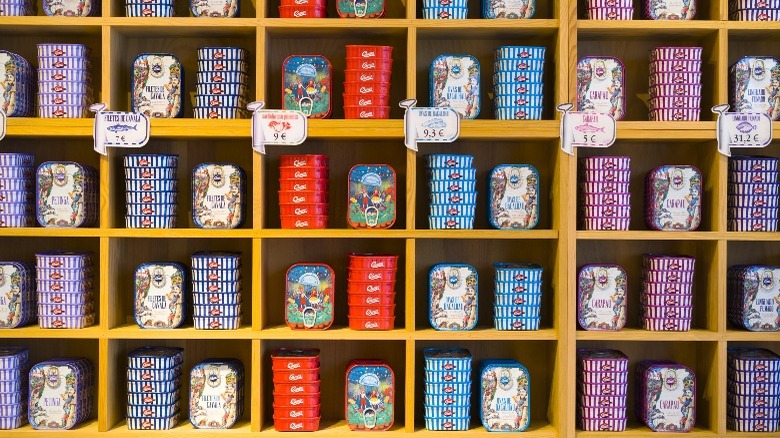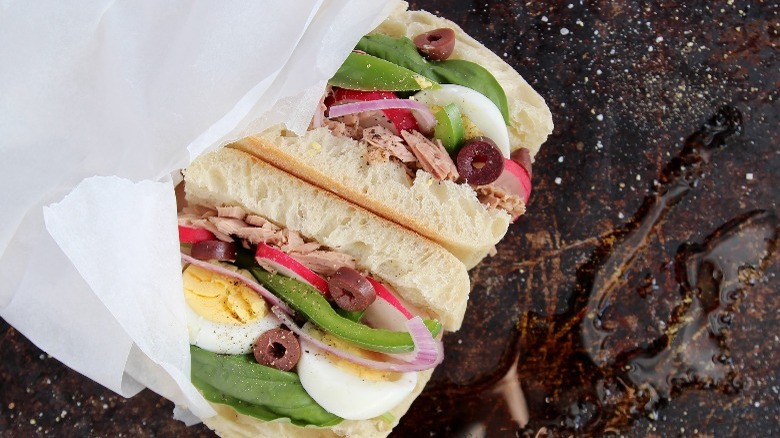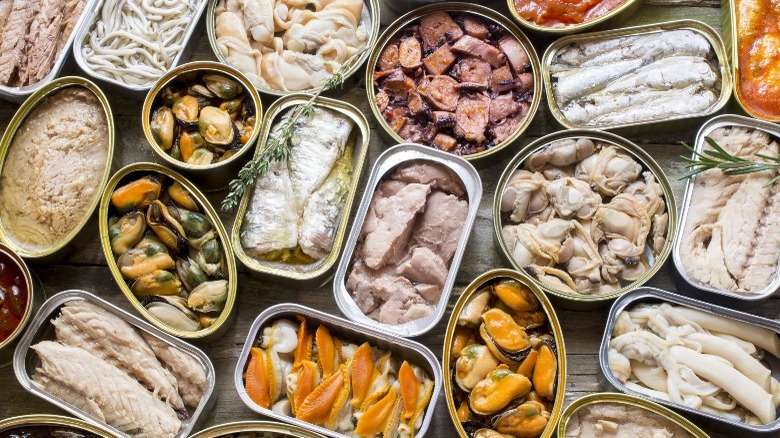Are You Missing Out On Gourmet Tinned Tuna?
We may receive a commission on purchases made from links.
Tuna has been a lunchtime staple ever since the canned version of this fish was introduced to the marketplace in the early 20th century (per Smithsonian). Often mixed with mayonnaise and served as "tuna salad," between two slices of bread, with melted cheese on toast, or topping lettuce leaves, there is something intrinsically homey about our love affair with tuna. Maybe it's the inextricable link from mom's tunafish sandwiches, paired with the warm comfort of tomato soup, or slipped inside bagged school lunches with crisp potato chips (both of which ended up smashed flat from the journey).
But once you reach adulthood, a more grown-up presentation of that tuna lunch begins to take shape Maybe you find yourself adding ingredients like butter lettuce, whole grain mustard, and capers for a gluten-free take on an open-faced tuna sandwich or laid atop a bed of lettuce, green beans, boiled eggs, potatoes, and olives for a delicious (but highly-debated in its authenticity), salad Niçoise.
After a while though, tuna settles in your mind as a healthy and affordable protein that's easy to throw together on a busy lunch day. Reliably tasty and easy, it's something that, occasionally, you can elevate to the heights of the very best in French salads. Still, there's nothing sexy about tuna in a can, especially not when it is freshly caught, grilled or sashimi counterparts are out there just waiting to be sampled in the gleaming minimalist dining rooms of today's chicest eateries.
Or is there?
Artisanal tuna: Sophisticated and sustainable?
While some canned tuna brands can admittedly be bland, dry, or just downright icky, there are a lot of great reasons to level up your tuna game beyond better taste — not the least of which is environmental concerns. According to Greenpeace, tuna purveyors come in a spectrum of responsibility to the consumer, and depending on where a brand lands on that spectrum, your tuna purchase could be contributing to the endangerment of aquatic species like sharks, rays, dolphins, and sea turtles and even be bad for the planet, destroying delicate ocean eco-systems with their destructive fishing practices.
Choosing responsibly sourced, sustainable tuna over brands that have little to no transparency regarding their efforts at preserving sea life and ecosystems may mean paying a bit more, but doing so will not only pay big rewards for our oceans but also for your tastebuds. A case Bon Appetit makes compellingly, noting that it's best to get to know the responsible brands and remember your faves, saying "We like Genova, Tonnino, both certified by the Marine Stewardship Council, and Bela and Ortiz, which are pole-and-line-caught off the European coast."
Seafood Watch advises the very best canned tuna comes "pole-and-line-caught" or "troll-caught" (which helps to prevent overfishing) and "FAD-free," "free school," "school-caught," or "unassociated purse seine," (methods that significantly reduce bycatch — the unintended catching of other sea life beyond their target). Tuna from these ocean-friendly brands are carefully sourced and just as carefully filleted and packaged.
Is the taste worth the cost?
Sustainability alone makes buying these tuna brands worth the cost, but the quality, flavor, and attractive packaging add to the luxe tuna experience. Many of these more upscale brands offer thick chunks of firm but tender, often olive oil-soaked or marinated tuna in albacore, yellowtail, and skipjack varieties, packed in glass jars and pleasing tins that are simply a cut above the most popular but unsustainable grocery chain brands.
For a less chi-chi but sustainable canned tuna experience, Monterey Bay Aquariums' Seafood Watch (which doesn't formally endorse any specific tuna brands) notes brands like American Tuna, Fishing Vessel St. Jude, Mind Fish Co., Ocean Naturals, Safe Catch, Wild Planet, and Whole Foods 365 offer "Best Choice," "Good Alternative," or "certified canned tuna."
Besides sustainability, there's mercury content to consider, too. As Livestrong points out, tuna contains high amounts of mercury (which is a neurotoxin) and other heavy metals when compared with other fish. Because of this high mercury content, you should limit your consumption to one 4-ounce serving per week of albacore or two to three 4-ounce servings of light tuna (skipjack or yellowtail varieties) each week.
Tinned tuna: Get the good stuff
If you have to limit your tuna intake, shouldn't it be the best when you do get to have it?
That's the approach the newest artisanal tunas on the market are taking. Brands like Jose Gourmet, Scout Tuna, and Freshé are rethinking tinned tuna, transforming it from an everyday workhorse to an elegant treat. While quality canned seafood is certainly not new to the rest of the world or your boutique gourmet shops, it going mainstream in the US is a fairly new trend. Packaged in glass jars (Tonnino, King Oscar, Bela), colorfully decorated tins (Ortiz, Genova, Freshé), and cans inside boxes covered in engaging artwork (Scout, Jose Gourmet), these brands are focusing not only on quality but quality of life when it comes to their canned tuna and other tinned seafood. Building their brands on sustainability, flavor, fair trade, and on serving their communities.
But seafood like this comes with a higher price tag. It's the cost of doing business ethically and eco-consciously. And when you buy this tuna that's what you're voting for, good food without sacrificing the workers who made it all possible or the ocean ecosystems we depend on. And while you won't mistake these canned offerings for the best Nobu has to offer, you can bet these artisanal tinned tuna brands will have you crushing on this cold water fish like never before.



